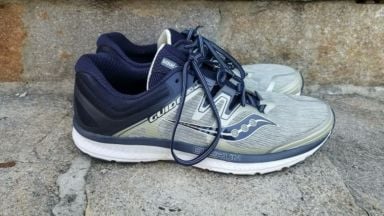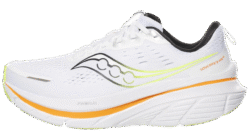The guide has been given the ISO treatment by Saucony! Is this much change good though? I was skeptical going into this review because of it.
I recently reviewed a pair of Saucony’s Hurricane ISOs and was not impressed with ISOFIT. At best it seemed like a gimmick. The Guides are a solid stability trainer already, so why fix something that isn’t broken?
Thankfully, I had a mostly positive experience with the Guides. After a long break in period, the shoes were a blast to test.
Saucony Guide ISO General Info


Saucony Guide ISO – Toe
The Guide ISO is the successor to the Guide 10 from Saucony. Because the ISOFIT system in the upper is such a drastic change, Saucony has been rebranding and restarting the numbering. This is the latest shoe to get such treatment.
It is one of Saucony’s flagship stability shoes and gets a lot of attention. It competes with other moderate stability shoes such as ASCIS’ GT-2000 and Brooks’ Ravenna.
I liked how the shoes looked upon unboxing. I’m not usually a huge fan of lighter, neutrally colored shoes but these had a nice pop to them. The reflective accents were subtle yet apparent.
When I first laced them up, they felt tight and stiff. the first few runs in them felt a little restrictive.
Saucony Guide ISO Sole Unit
The EVERUN midsole is back and remains why I put Saucony above the rest. It is a compound that promotes continuous cushioning and a higher return on liftoff. I’ll spare you the numbers that Saucony throws out bragging about it; but I can say that it works.


Saucony Guide ISO – Medial Side
The tri flex out sole pattern has a high attention to detail that gave me great control. I was able to make turns quick and had no traction issues in inclement weather.
I found myself landing and lifting off mostly on my forefoot thanks to the 8mm drop. The springboard like feel of EVERUN allowed me to go fast without a lot of effort.


Saucony Guide ISO – Sole
Saucony’s got a good thing going with their stability line and the Guide ISO is no exception. It offers moderate support for over pronators; but is not bulky like its big brother, the Hurricane. It is not bare bones like the new lighter Liberty ISO either.
It can be hard to differentiate between the Guide and Saucony’s other stability model, the Omni. Both are around the same weight, cushioning, and have an 8mm drop. The difference is in the ride.
I found the ride to be more controlled with the ISO Guide, where the Omni pushed me forward to the point where my calves were working overtime. The arch is a little bulkier not offering as much flexibility; but gives a smoother ride and better ground control when my feet hit the ground.
The firmer, stable ride of the shoe makes it ideal for medium to long distance running . It allowed me to lock into a comfortable pace and made miles go by effortlessly.
Saucony Guide ISO Upper Info
The upper has been completely redone with the ISOFIT system. It is a two fold system with a sock like sleeve made out of mesh. This is coupled with detached overlays that are designed to morph to the top of the foot.
It is something that is overhyped on Saucony’s website. My first encounter with it had me thinking it was merely another gimmick, but it was executed rather well with the Guide. The overlays wrapped onto my foot comfortably and gave a great fit.
Unlike the rest of the upper, the heel remains firm. It locks me in when I wear them and cups to the back part of my foot nicely.
The toe box felt restrictive at first. I had little wiggle room and the upper material almost morphed to my foot too much.
After about 30 miles, it finally started to give. I don’t see a need to size up, just give the break in period a little bit of patience.
Saucony Guide ISO Conclusions
I got to use these shoes during the peak of a marathon training cycle. They took a little bit to break in, but they were fun to run some of my volume heavy weeks in while I was getting ready for my race.
The longest run I did in them was 15 miles. I found it easy to go fast and my body didn’t feel shredded afterwards. Fast miles were easy to achieve and the cushioning didn’t hold me back.
One thing I did find interesting, was that there was a hot spot in the inner arch of my foot. There was abundant rubbing when I ran that caused blistering on a part of my foot that has never had issues before.
I like to hope it was just an isolated issue unique to me, but it was too much not to bring up.
All in all, the Guide was treated well with the ISOFIT upgrade. It sold me on this unique upper system that Saucony is going full steam ahead with.
We purchased a pair of Saucony Guide ISO from runningwarehouse using our own money. This did not influence the outcome of this review, written after running more than 50 miles in them.
Saucony Guide ISO Price Comparison
This page contains affiliate links. As an Amazon Associate I earn from qualifying purchases.





































